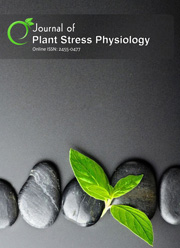Evaluating the growth potential of Vigna radiata (green gram) using Albizia amara (AA) and Leucaena leucocephala (LL) as a phytoremediator for textile dye (Navy blue dye) simulated soil
Abstract
 Soil pollution due to textile dye affects the soil fertility, is a cause for demand crop production in agriculture. The present investigation was to evaluate the growth level of Vigna radiata (green gram) before and after simulation of dye in soil. Germination, biometric evaluation (root length, leaf area, shoot length and plant height) and biochemical activity (Total protein, amino acids, DNA, total carbohydrate and amylase activity) were analyzed. All the process carried out with 1% concentration of dye to assess remediating capacity of plant biomass Albizia amara (AA) and Leucaena leucocephala (LL). Use of these adsorbents as phytoremediator could enhance the binding capacity of blue dye to a great extent shows the phytotoxicity of dye upto 1% in soil.
Downloads
References
Cameron GR, Milton RF and Allen JW (1943). Measurement of flavonoids in plant samples. Lancet, p. 179.
Evans, WC. (1997). An index of medicinal plants. A Text book of Pharmacognosy. 14 ed. 7(5) 12-14. Ecobiol., 19 (1): 19-22. Electrochemical methods. Water Res. 28: 277-282.
Fisher DD (1968). Protein staining of ribboned upon section for light microscopy. Histochemistry, 16: 81-96.
Harborne, J. B. (1987). Methods in Plant Biochemistry: Academic Press; London, 1987.
Hedge, J. E. and. Hofreiter, B. T . (1962). Determination of Total Carbohydrate by Anthrone Reagent. In: Carbohydrate Chemistry, Whistler, R.L. and J.N. Be Miller (Eds.).Academic Press, New York.
Huicheng Xie., Chuanrong Li., Jingwei Xu and Hui Li. (2014).The mechanism of evans blue removal by sunflower. Journal of Chemical and Pharmaceutical Research, 6(1):327-331.
ISTA (1985): International rules for seed testing. Seed Sci. Technol., 13: 299–355.
Jaqueline Matos Cruz., Paulo Renato Matos Lopes., Renato Nallin Montagnolli., Ivo Shodji Tamada., Natália Maria, Maciel Guerra Silva., Ederio Dino Bidoia (2013).Toxicity Assessment of Contaminated Soil Using Seeds as Bioindicators. Journal of Applied Biotechnology (1):1.
Jones D. L. and K. Kielland. 2012. Amino acid, peptide and protein mineralization dynamics in a taiga forest soil. Soil Biology & Biochemistry 55: 60–69.
Khouni Imen , Benoit Marrot, Raja Ben Amar (2010) Decolourization of the reconstituted dye bath effluent by commercial laccase treatment: Optimization through response surface methodology. Chemical Engineering Journal. Vol (156),pp: 121–133.
Lowry, O.H., Rosebrough, N.J., Farr, A.L., and Randall, R.J. (1951). J.Biol.Chem 193: 265.
Mace ME (1963). Histochemical localization of phenols in healthy and diseased tomato roots. Phytochem. 16, 915-925.
Nooshin Karimi(2013).Comparative phytoremediation of chromium-contaminated soils by Alfalfa (Medicago sativa) and Sorghum bicolor (L) Moench International Journal of Scientific Research in Environmental Sciences (IJSRES),Vol 1(3), pp. 44-49. original method)
Peter Bernfied.(1955).In.Methods of Enzymology (Eds.Colowick S and Kalpana NO) Academic press. New York.1:149.
Pikovskaya R. E. (1948). Mobilization of phosphorous in soil in connection with vital activity of some microbial species. Microbiologiya. 17: 362 - 370.
Ramakrishnan S and Rajan R (1994). Text book of Medical Biochemistry (2nd Ed). Orient Longman, New Delhi, India. pp. 582.
Waldi, D. (1951). In Thin-layer chromatography. A laboratory handbook. (Edited by Egon Stahl. Academic Press, Inc., New York. 491.
Wang, C., Yediler, A., Linert, D., Wang, Z., Kettrup, A., (2002) Toxicity evaluation of reactive dye stuff, auxiliaries and selected effluents in textile finishing industry to luminescent bacteria vibrio fisheri. Chemosphere;46, pp 339-344.
Wiwart M., Mos M and Wojtowicz W. (2006). Studies on the imbibition of triticale kernels with a different degree of sprouting, using digital shape analysis. Plant Soil Environ.52 (7): 328-334.



 .
.